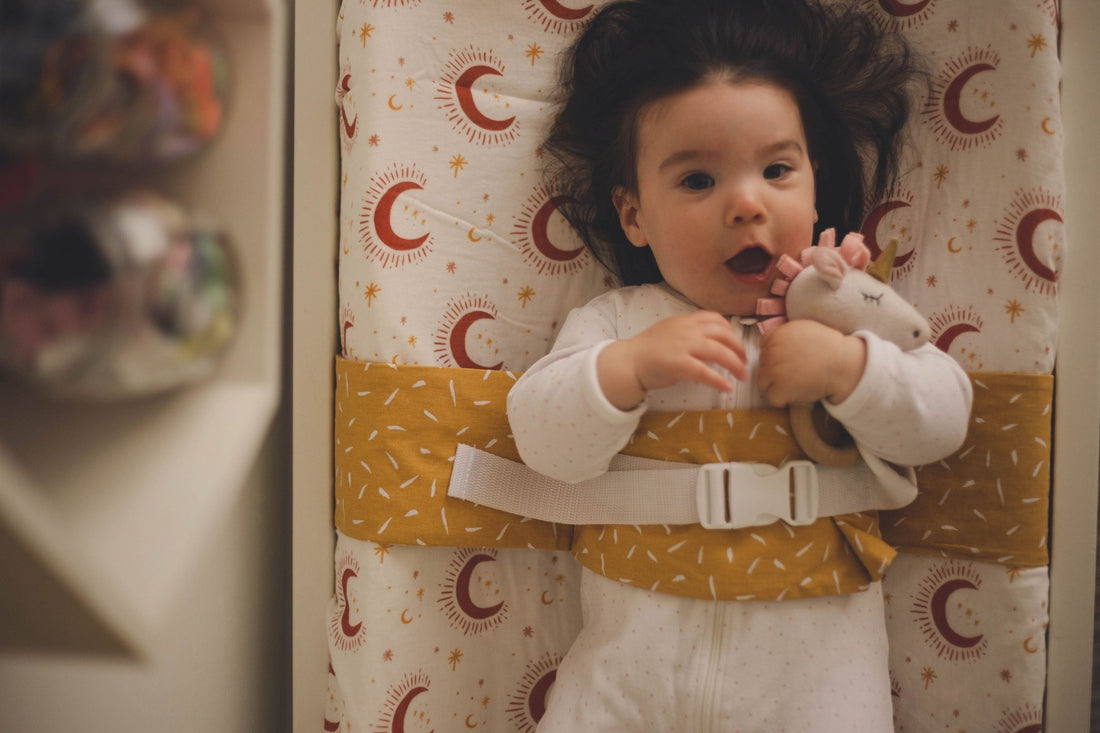
Top ten change time tips
Nappy Changing 101
1. Roll and stick disposables
The best way to dispose of a (disposable) nappy is to roll it up into itself with the two sticky tabs pulled out and then use those tabs to hold the rolled nappy together.
2. Nappy as the first wipe
The front section of a dirty nappy is often still clean when you go to change baby and can be used to wipe away the majority of mess from bub. Quick and easy, it will save you a few wipes too.
3. Wetness indicator
A lot of nappies have a thin yellow strip on the outside of the nappy. When the nappy gets wet, the strip turns blue. This is a really handy reminder that a baby needs a nappy change – especially in the newborn days.

4. Nappy choice
There are endless options when it comes to nappies. When choosing whether you’ll go with disposables, cloth, or a combination of both, the most important thing to consider is what is going to work best for you.
Talking to other mums about what they use and why is a great way to work through your options and will give you a good idea of all the pros and cons.
Before buying a massive pack of disposables, some brands offer sample packs to trial. Some cloth nappy brands also offer trial nappies at a lower cost than their standard ranges.
No matter what, don’t be afraid to change your mind if your first choice doesn’t work out! Keep trying until you find the right one.
5. Going up
It can pull at your mama heartstrings when it’s time to move up to the next size in nappies or clothes, but these are a few indicators that the time has come:
- Baby is on the upper end of the recommended weight scale, or weighs more than the nappies are recommended for.
- Baby has marks after wearing a nappy or the waist is getting a bit too snug - the tabs aren’t wrapping around easily.
- The nappy is leaking regularly or you’ve had a few blowouts.

6. Rid the rash with creams or powders
Nappy rash isn’t fun for anyone, but unfortunately, it’s common. There are so many creams and powders available to buy so it can be confusing to know which is going to be the best for your baby. Every mum has their own preference.
- You’ll only know which one is best for your bub once you’ve given them a go, so start with a small tub or tube first. Chemists often have sample-sized packs you can try.
- Sometimes using two can be a winning combination – for example, a powder during the day and a super thick cream overnight might do the trick.
- Tubes or pump bottles make application so much easier. With tubs, always use a scoop or a clean finger; never double dip to ensure you don’t pass germs back into the pot.
- Continue to use the cream or powder until all signs of the rash are gone, and even then, continue to use it now and again to avoid another flare-up.
- Some of the most popular creams and powders for nappy rash include:
- MooGoo Nappy Goo Cream
- Sudocrem
- Vaseline
- Bepathene
- Curash powder
- Daktozin
- Dermeze Treatment Ointment
7. Reducing the rash
Besides the creams, powders and potions, there are a few things you can do to help your baby’s nappy rash.
- Ditch the wipes and use a wet washer with warm water
- Nappy-free time (when you can!)
- Change baby regularly and ASAP when they have a dirty nappy. If they're at childcare, ask their educators to check them on the hour.
- Soaps, detergents and fragrances can irritate. Consider:
- sensitive washing detergent or powder
- fragrance-free wipes
- a gentle moisturiser made for babies with sensitive skin
- a soap-free body wash and ditching the bubble bath
Highly acidic fruits such as strawberries, oranges, lemons, pineapples, and tomatoes and tomato-based products can exaggerate nappy rash symptoms. Consider reducing or omitting these foods from your child's diet.
If your baby’s nappy rash is spreading, hasn’t improved after a week or is causing your little one to be upset or not sleep, please go and see your GP quick-smart.
8. Hands-on
Some babies start rolling at around 3 or 4 months old and most will be rolling by 6 or 7 months. Even if you haven’t seen your bub roll yet, never leave them unattended on a change table; it may just be the time they decide to start rolling for the first time. Always keep one hand on bub during change time to make sure you can prevent them from flipping over.
9. Poo-free nights
Babies usually stop pooing overnight from about four months. From then on, you can let them sleep and change their nappy when they wake (hopefully in the morning….!).
10. Don’t get caught out
When baby is screaming, you’ve just dealt with a poonami and you’re running late for an appointment, it can be easy to forget to pack up your bag. Make a habit of restocking it with nappies, some nappy bags, wipes, a spare onesie and some hand sanitiser as soon as you get home, but also pack an extra set of these supplies in the boot of your car so you’re never left stranded. Your future self will love you for it.
Have you got another nappy-changing tip new mums need to know about? Share your change time tip below!
Photography: Lucinda Catherine Photography@lucindacatherinephotography
